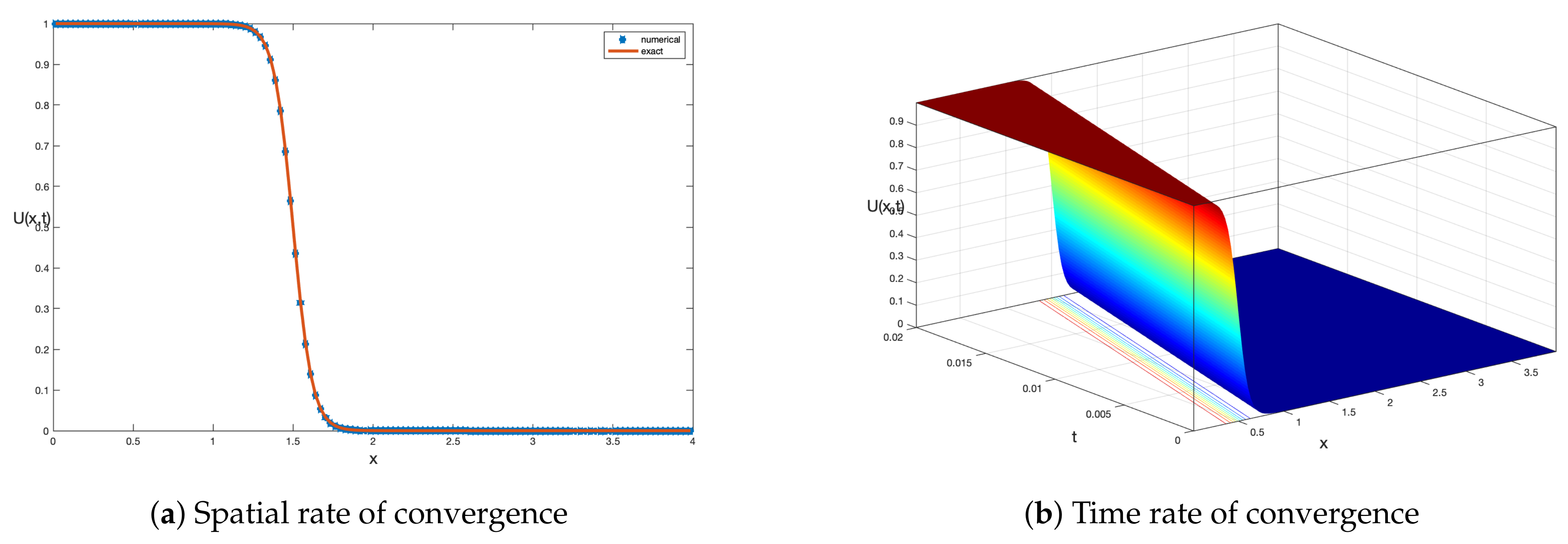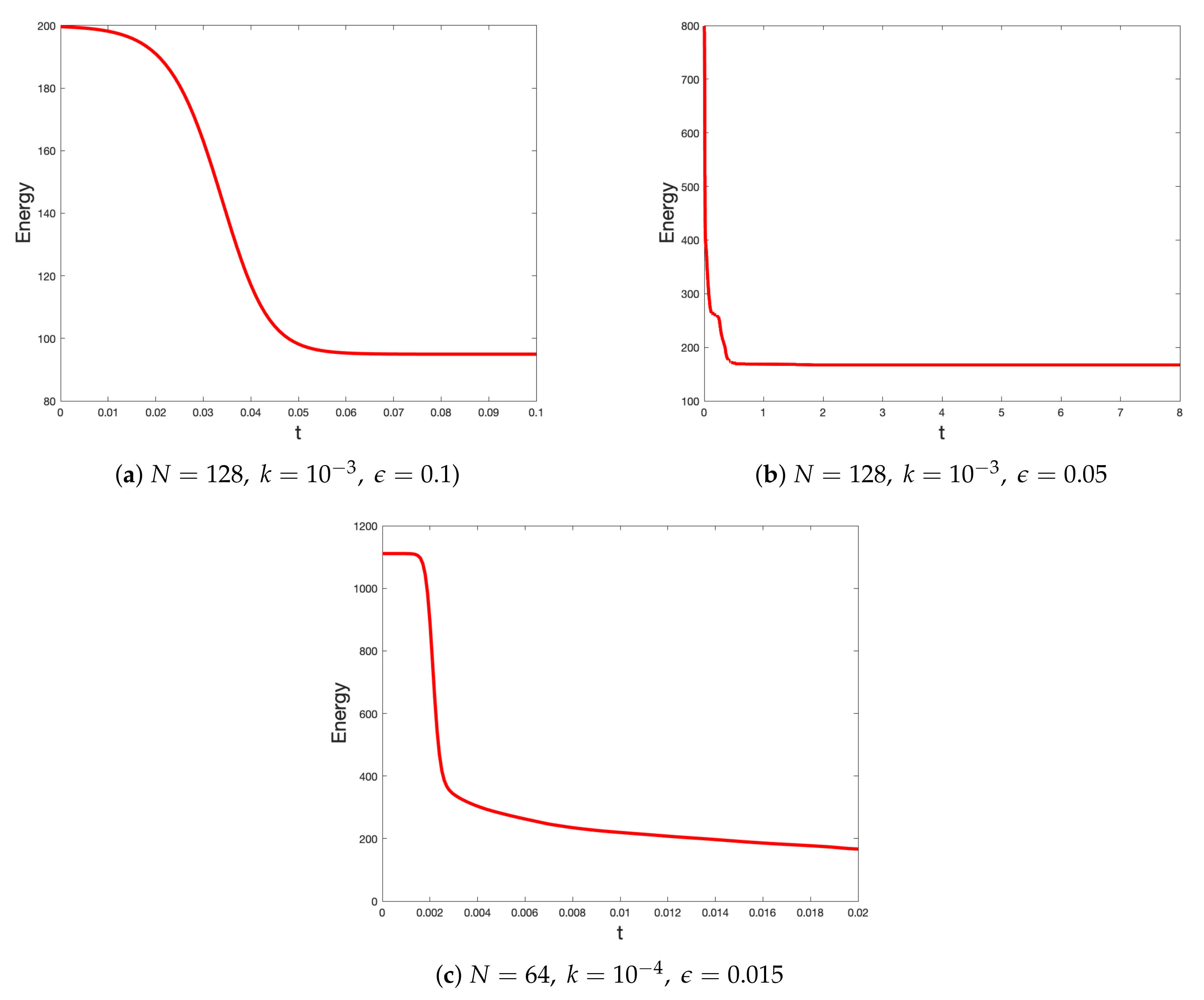Fourier Spectral High-Order Time-Stepping Method for Numerical Simulation of the Multi-Dimensional Allen–Cahn Equations
Abstract
1. Introduction
2. Fourier Spatial Discretization
3. Temporal Discretization
FFT Implementation of the ETDRK4-P13 Method
| Algorithm 1 ETDRK4-P13 method. |
|
4. Computational Results and Discussion
4.1. Problem 1 (Traveling Wave Solution)
4.2. Problem 2 (Mean Curvature Problem)
4.3. Problem 3 (3D AC Equation)
4.4. Problem 4 (Spinodal Decomposition in 3D)
4.5. Stability Test
5. Conclusions
Author Contributions
Funding
Institutional Review Board Statement
Informed Consent Statement
Data Availability Statement
Conflicts of Interest
References
- Joshi, J. Existence and nonexistence of solutions for sublinear problems with prescribed number of zeros on exterior domains. Electron. J. Differ. Equ. 2017, 133, 1–10. [Google Scholar]
- Joshi, J.; Iaia, J. Existence of solutions for semilinear problems with prescribed number of zeros on exterior domains. Electron. J. Differ. Equ. 2016, 112, 1–11. [Google Scholar]
- Joshi, J.; Iaia, J. Infinitely many solutions for a semilinear problem on exterior domains with nonlinear boundary condition. Electron. J. Differ. Equ. 2018, 108, 1–10. [Google Scholar]
- Allen, S.M.; Cahn, J.W. A microscopic theory for antiphase boundary motion and its application to antipahse domain coarsening. Acta Metall. 1979, 27, 1085–1095. [Google Scholar] [CrossRef]
- Du, Q.; Liu, C.; Wang, X. A phase field approach in the numerical study of the elastic bending energy for vesicle membranes. J. Comput. Phys. 2004, 198, 450–468. [Google Scholar] [CrossRef]
- Evans, L.C.; Sooner, H.M.; Souganidis, P.E. Phase transitions and generalized motion by mean curvature. Commun. Pure Appl. Math. 1992, 45, 1097–1123. [Google Scholar] [CrossRef]
- Evans, L.C.; Spruck, J. Motion of level sets by mean curvature. I. J. Differ. Geom. 1991, 33, 635–681. [Google Scholar] [CrossRef]
- Feng, X.B.; Prohl, A. Numerical analysis of the Allen–Cahn equation and approximation for mean curvature flows. Numer. Math. 2003, 94, 33–65. [Google Scholar] [CrossRef]
- Liu, C.; Shen, J. A phase field model for the mixture of two incompressible fluids and its approximation by a Fourier-spectral method. Physica D 2003, 179, 211–228. [Google Scholar] [CrossRef]
- Yang, X.; Feng, J.J.; Liu, C.; Shen, J. Numerical simulations of jet pinching-off and drop formation using an energetic variational phase-field method. J. Comput. Phys. 2006, 218, 417–428. [Google Scholar] [CrossRef]
- Yue, P.; Zhou, C.; Feng, J.J.; Ollivier-Gooch, C.F.; Hu, H.H. Phase-field simulations of interfacial dynamics in viscoelastic fluids using finite elements with adaptive meshing. J. Comput. Phys. 2006, 219, 47–67. [Google Scholar] [CrossRef]
- Yue, P.; Feng, J.J.; Liu, C.; Shen, J. Diffuse-interface simulations of drop coalescence and retraction in viscoelastic fluids. J. Non-Newtonian Fluid Mech. 2005, 129, 163–176. [Google Scholar] [CrossRef]
- Choi, J.W.; Lee, H.G.; Jenog, D.; Kim, J. An unconditionally gradient stable numerical method for solving the Allen–Cahn equation. Physica A 2009, 388, 1791–1803. [Google Scholar] [CrossRef]
- Lee, H.G.; Lee, J.Y. A semi-analytical Fourier spectral method for the Allen–Cahn equation. Comput. Math. Appl. 2014, 68, 174–184. [Google Scholar] [CrossRef]
- Lee, H.G.; Lee, J.Y. A second order operator splitting method for Allen–Cahn type equations with nonlinear source terms. Physica A 2015, 432, 24–34. [Google Scholar] [CrossRef]
- Li, Y.; Lee, H.G.; Jeong, D.; Kim, J. An unconditionally stable hybrid numerical method for solving the Allen–Cahn equation. Comput. Math. Appl. 2010, 60, 1591–1606. [Google Scholar] [CrossRef]
- Peaceman, D.; Rachford, H. The numerical solution of parabolic and elliptic differential equations. J. Soc. Ind. Appl. Math. 1955, 3, 28–41. [Google Scholar] [CrossRef]
- Shen, J.; Tang, T.; Yang, J. On the maximum principle preserving schemes for the generalized Allen–Cahn equation. Commun. Math. Sci. 2016, 14, 1517–1534. [Google Scholar] [CrossRef]
- Tang, T.; Yang, J. Implicit-explicit scheme for the Allen–Cahn equation preserve the maximum principle. J. Comput. Math. 2016, 34, 451–461. [Google Scholar]
- Yang, X. Error analysis of stabilized semi-implicit method of Allen–Cahn equation. Discret. Contin. Dyn. B 2009, 11, 1057–1070. [Google Scholar] [CrossRef]
- Zhang, J.; Du, Q. Numerical studies of discrete approximations to the Allen–Cahn equation in the sharp interface limit. SIAM J. Sci. Comput. 2009, 31, 3042–3063. [Google Scholar] [CrossRef]
- Argyros, I.K. Computational Theory of Iterative Methods; Series: Studies in Computational Mathematics; Elsevier Publication Company: New York, NY, USA, 2007. [Google Scholar]
- Argyros, I.K.; Magrenan, A.A. Iterative Methods and Their Dynamics with Applications; CRC Press, Taylor and Francis: Boca Raton, FL, USA, 2017. [Google Scholar]
- Bhatt, H.; Chowdhury, A. Comparative analysis of numerical methods for the multidimensional Brusselator system. Open J. Math. Sci. 2019, 3, 262–272. [Google Scholar] [CrossRef]
- Gottlieb, S.; Wang, C. Stability and convergence analysis of fully discrete Fourier collocation spectral method for 3-D viscous Burgers’ equation. J. Sci. Comput. 2012, 53, 102–128. [Google Scholar] [CrossRef]
- Cheng, K.; Wang, C. Long time stability of high order multi-step numerical schemes for two-dimensional incompressible Navier-Stokes equations. Siam J. Numer. Anal. 2016, 54, 3124–3144. [Google Scholar] [CrossRef]
- Chen, W.; Li, W.; Wang, C.; Wang, S.; Wang, X. Energy stable higher-order linear ETD multi-step methods for gradient flows: Application to thin film epitaxy. Res. Math Sci. 2020, 7, 13. [Google Scholar] [CrossRef]
- Yen, Y.; Chen, W.; Wang, C.; Wise, S.M. A second-order energy stable BDF numerical scheme for the Cahn-Hilliard Equation. Commun. Comput. Phys. 2018, 23, 572–602. [Google Scholar] [CrossRef]
- Bueno-Orevo, A.; Kay, D.; Burrage, K. Fourier spectral methods for fractional-in-space reaction-diffusion equations. BIT 2014, 54, 937–954. [Google Scholar] [CrossRef]
- Pindza, E.; Owolabi, K.M. Fourier spectral method for higher order space fractional reaction–diffusion equations. Comm. Nonlinear Sci. Numer. Simulat. 2016, 40, 112–128. [Google Scholar] [CrossRef]
- Cox, S.M.; Matthews, P.C. Exponential time differencing for stiff systems. J. Comput. Phys. 2002, 176, 430–455. [Google Scholar] [CrossRef]
- Bhatt, H.P.; Khaliq, A.Q.M. A compact fourth-order L-stable scheme for reaction-diffusion systems with nonsmooth data. J. Comput. Appl. Math. 2016, 299, 176–193. [Google Scholar] [CrossRef]
- Ayub, S.; Affan, H.; Shah, A. Comparison of operator splitting schemes for numerical solutions of the Allen–Cahn equation. AIP Adv. 2019, 9, 125202-1–125202-9. [Google Scholar] [CrossRef]
- Zhai, S.; Feng, X.; He, Y. Numerical simulation of the three dimensional Allen–Cahn equation by the high-order compact ADI method. Comput. Phys. Commun. 2014, 185, 2449–2455. [Google Scholar] [CrossRef]






| k | Order | |
|---|---|---|
| 3.6080 | - | |
| 2.6027 × | 3.7931 | |
| 1.7485 × | 3.8959 | |
| 1.13476 × | 3.9456 |
| k | Order | |
|---|---|---|
| 1.4048 × | - | |
| 1.0766 × | 3.7058 | |
| 7.5300 × | 3.8377 | |
| 4.9918 × | 3.91450 |
| k | Order | |
|---|---|---|
| 5.1146 × | - | |
| 3.1501 × | 4.0211 | |
| 1.9580 × | 4.0079 | |
| 1.2523 × | 3.9667 |
Publisher’s Note: MDPI stays neutral with regard to jurisdictional claims in published maps and institutional affiliations. |
© 2021 by the authors. Licensee MDPI, Basel, Switzerland. This article is an open access article distributed under the terms and conditions of the Creative Commons Attribution (CC BY) license (http://creativecommons.org/licenses/by/4.0/).
Share and Cite
Bhatt, H.; Joshi, J.; Argyros, I. Fourier Spectral High-Order Time-Stepping Method for Numerical Simulation of the Multi-Dimensional Allen–Cahn Equations. Symmetry 2021, 13, 245. https://doi.org/10.3390/sym13020245
Bhatt H, Joshi J, Argyros I. Fourier Spectral High-Order Time-Stepping Method for Numerical Simulation of the Multi-Dimensional Allen–Cahn Equations. Symmetry. 2021; 13(2):245. https://doi.org/10.3390/sym13020245
Chicago/Turabian StyleBhatt, Harish, Janak Joshi, and Ioannis Argyros. 2021. "Fourier Spectral High-Order Time-Stepping Method for Numerical Simulation of the Multi-Dimensional Allen–Cahn Equations" Symmetry 13, no. 2: 245. https://doi.org/10.3390/sym13020245
APA StyleBhatt, H., Joshi, J., & Argyros, I. (2021). Fourier Spectral High-Order Time-Stepping Method for Numerical Simulation of the Multi-Dimensional Allen–Cahn Equations. Symmetry, 13(2), 245. https://doi.org/10.3390/sym13020245







